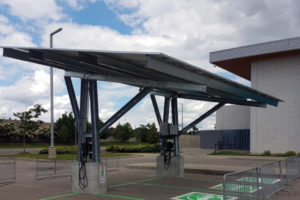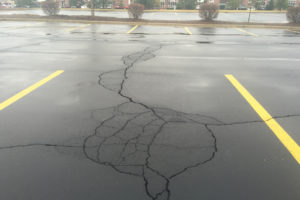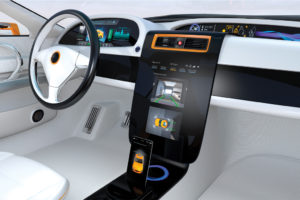By Jay Boychuk and Lisa Oelke, hb Solar Canada
Parking lots are assets for those that charge for the spaces within them, or need them to attract customers or even employees. They serve one main purpose, to provide a place to leave cars, whether it is for an hour, or a day. What if that asset could be turned into a multi-purpose piece of land that not only provides parking, but generates additional cashflow, and helps the environment? Parking lots can do a surprising thing, they can generate electricity, and not only that, its green energy. Introducing solar covered parking can do just that.
Why would a parking lot operator want to be a producer of green energy? Large cities can have a tremendous amount of asphalt covered surfaces, some above 40% of their land mass. Suburban areas don’t escape these large amounts of asphalt coverage either. A lot of that density is roadways, with surface parking lots significantly adding to the total as well. What does all this asphalt do to our environment if we just use it for parking cars?
When it comes to identifying the greatest challenge to meeting Green House Gas (GHG) reductions, transportation leads in Ontario as the single-largest emitting sector in the economy at 35%. In response to these statistics, the Ontario Government is encouraging drivers to switch to electric vehicles, (EV’s) by offering rebates of up to $14,000 with the purchase of an EV. Quebec and B.C. have similar statistics and have also offered incentives. The Electric Vehicle Chargers Ontario(EVCO) incentive serves to increase access to charging stations with funding to build a network of fast-charging EV stations in cities, along highways, at workplaces, apartments, condos, and public places across Ontario. These measures create demand for additional EV charging in locations where cars need
to park…
By Scott Sounart, PE
Parking lots play a vital role in the success of the buildings they serve, serving as a de-facto lobby and delivering the initial impression of the property. A run-down parking lot creates an unattractive and unwelcoming image that makes the entire complex seem less appealing and inviting. Perhaps more importantly, a derelict lot can also pose potentially hazardous conditions for visitors and employees and their vehicles. Not only can this undermine a business by making it’s location less attractive to potential customers, but it can also lead to costly legal liability if visitors or employees suffer personal injury or damaged vehicles.
Yet, in spite of the obvious hazards that can be caused by run-down or improperly maintained parking lots, many owners treat their lots as an afterthought. This is partly a perception problem. Many owners develop lots rather than a parkade because they mistakenly think that parking lots are essentially maintenance-free. They assume that they can just pave over an area of land, paint in stripes for spaces, and forget about it.
While it’s true that the typical lot requires less maintenance than a parkade, maintenance is required. Sure, there are no concrete ramps, floors, or support columns to care for, but a parking lot’s pavement undergoes a great deal of wear and tear every day from multi-ton vehicles, rain and snow, and even the rays of the sun. As such, it’s essential to have an assessment and maintenance plan to preserve the property’s aesthetics, ensure customer and tenant safety, and extend the service life of the pavement.
Pavements can be one of a commercial facility’s most expensive assets to maintain, but these costs can be minimized. There are seven primary types of asphalt distress, any one of which can require repair. The good news is that a pavement…
By Elizabeth Hueftlein
We’ve suffered enough from cold-cracked, pot-holed, muddy parking lots with puddles the size of lakes. Let’s face it, the Canadian climate just isn’t very kind to concrete and asphalt. And I won’t even mention the problems we’re dealing with when it comes to storm water runoff. It’s time for a solution, and there is one on the market made of 100% recycled plastic. Plastic has such a bad reputation, yet we still use it in so many different situations. Why not use a recycled plastic solution to solve your parking issue?
Think about the things you put in your recycling bin; ever wondered where they go once they’re loaded into the recycling truck? I’ll give you a general overview of the process that our products go through to go from waste to a useable ground reinforcement product that is used in parking lots.
Step 1: Sortation – the contents of the recycling boxes go to a materials recovery facility (MRF), called a “murf”. There, the different types of plastic are sorted, baled, and crushed or compacted.
Step 2: Processing – a recycling facility takes in the baled plastic and processes it into either a granulate or pellet. This is also the stage that colour pigment can be added to the plastic (in the case of pelletizing).
Step 3: Manufacturing – The granulate, or pellets can be mixed with other plastics to a specific “recipe” and colour called masterbatch is added to the granulate. The pellets or granulate are then shaped into a value-added product by injection or intrusion moulding.
It’s important to note that not all plastics behave the same way. There is a considerable amount of science behind creating useful products from plastic waste. In 2016 one company with a facility in St. Clements, ON helped divert 47,000 metric tonnes of…
By Danielle Desjardins
We are on the brink of a revolution, a revolution that will profoundly affect society, change the way cities look and function and fundamentally transform how people and goods move.
It’s been dubbed the “driverless revolution” and it will be brought about by the advent of autonomous vehicles (AV), cars that drive themselves with little or no human intervention. In addition to their effect on modes of transport, AVs are poised to disrupt many industries: transit, insurance, all industries that currently need drivers, driving support services, and the technology sector — large industries that will have to shift their strategies in the wake of driverless cars.
One major disruption could be on parking. Among other innovations, the revolution will bring, we will see AV fleets moving continuously between the various places they are needed, rendering the need for close and convenient parking spaces much less necessary.
As Alain L. Kornhauser of Princeton University told the online magazine Curbed, “Having parking wedded or close to where people spend time, that’s going to be a thing of the past. If I go to a football game, my car doesn’t need to stay with me. If I’m at the office, it doesn’t need to be there. The current shopping centre with the sea of parking around it, that’s dead.”1
How soon will that revolution begin? A number of car manufacturers predict that AVs will be launched about 2020, with many suppliers focusing first on driverless taxis. RethinkX, a think tank on technology-driven disruption, believes that by 2030 “95% of U.S. passenger miles traveled will be served by autonomous electric vehicles.” 2 Others foresee a clear majority of urbanites not even needing to own cars by 2040, because they’ll subscribe to some form of on-demand self-driving car service.3 McKinsey & Company believe that once technological…
By Brad Done
Parking lot safety all comes down to selecting the right bollard
Bollards are often over-looked but they play a significant role in the safety and aesthetics of almost every business. In a way, they are kind of like the masked vigilantes of a superhero movie—they never ask for thanks, they just silently protect the citizens and structures around them. That analogy might be a bit dramatic, but bollards really can save lives and prevent property damage. The key is selecting the right type for your business.
In its simplest form, a bollard is an unadorned metal post used in front of buildings or other outdoor spaces in which the flow of traffic must be controlled. They are normally spaced out so that typically-sized vehicles can’t get through them and this makes them an essential component of safe perimeters and parking lots. Bollards are available in varying colors, heights, widths and degrees of ornamentation and impact-resistance. A properly-chosen bollard will blend with a business’ architecture while providing an adequate level of impact-resistance to prevent property damage and protect pedestrians.
Normally, a business will select various types of traffic control bollard to perform these tasks on their property. Traffic bollards perform serval functions: they can help separate cars and pedestrians, clearly delineate where traffic is supposed to flow, block cars from pedestrian walk-ways, visually aid traffic in areas notorious for limited visibility, and enclose car-free zones.
Types of traffic control bollards
Not all traffic patterns are the same, and neither are all traffic control bollards. The type of bollard that should be selected depends on its primary purpose—will it be directing traffic in an area with changing traffic patterns, blocking off an area for an event, separating a bike lane, directing parking lot traffic, or doing something else entirely?
Here are four of the most…








